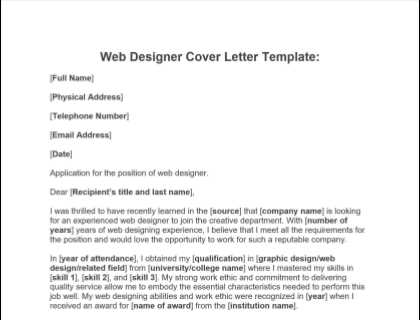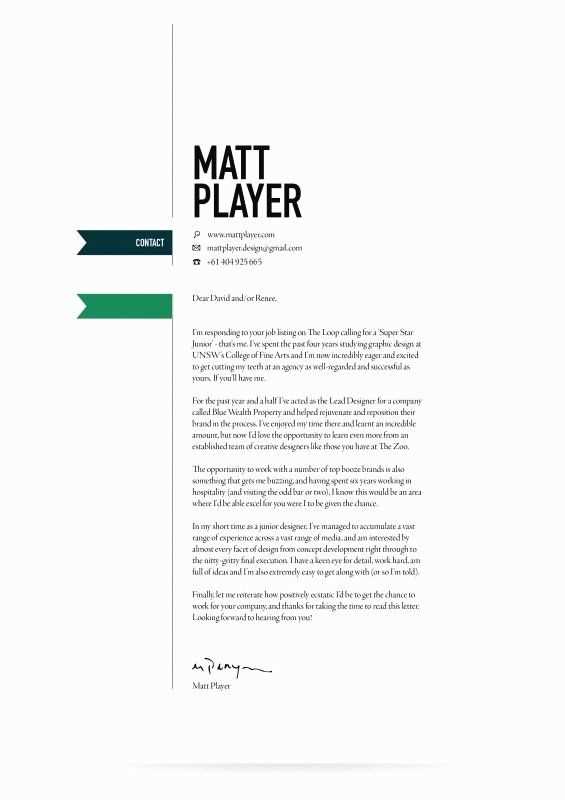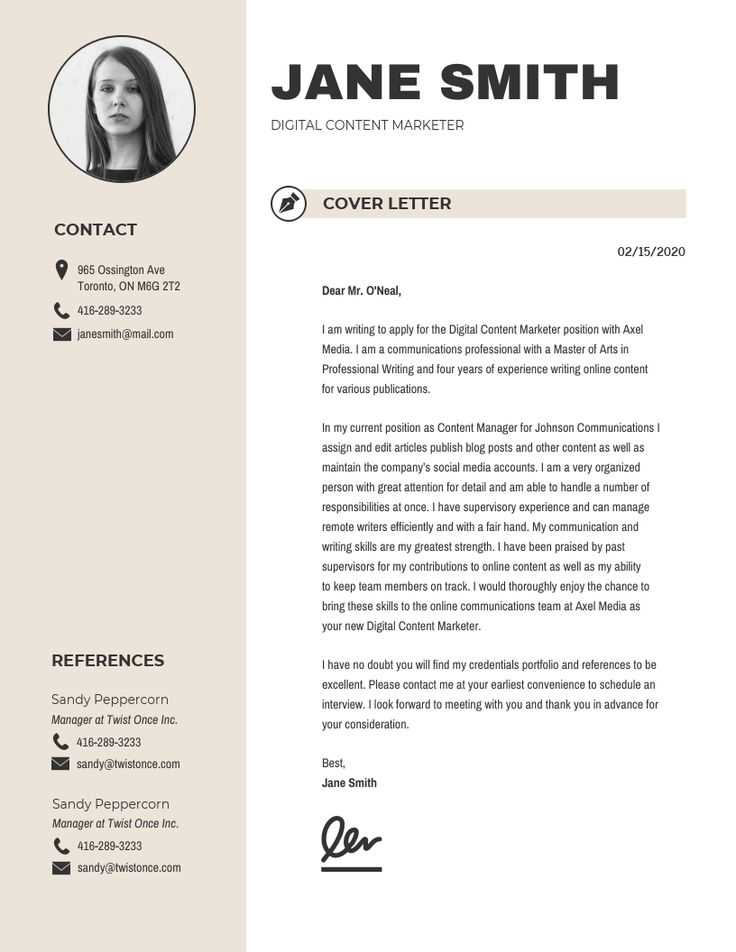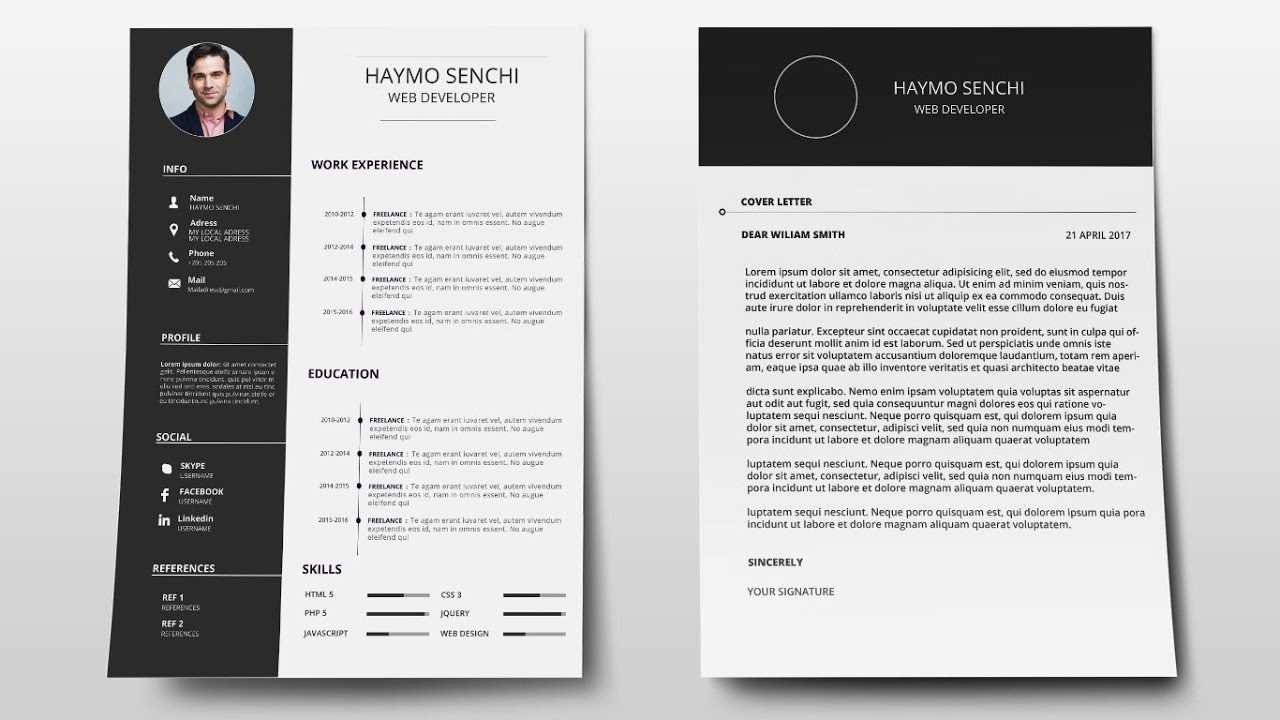Cover letter design template

A well-structured cover letter can make a lasting impression on hiring managers. Focus on clarity and brevity when crafting your letter. Keep it to one page, using a clean, professional layout that highlights your key qualifications and enthusiasm for the role.
Start with a clear heading that includes your contact information and the employer’s details. Use a formal greeting like “Dear [Hiring Manager’s Name],” and make sure to address the specific position you’re applying for right away. The introduction should express your interest in the job while briefly mentioning why you are a great fit.
In the body of the letter, emphasize how your skills align with the job requirements. Be specific–don’t just list general abilities, but focus on how your experience translates directly to the role you’re pursuing. Highlight relevant achievements or projects that show your impact, and make sure your personality and passion shine through.
Finally, end with a concise closing paragraph. Reiterate your interest and express your enthusiasm for the opportunity to discuss your application in more detail. Use “Sincerely” or another professional sign-off followed by your name. A strong cover letter design ensures that your qualifications stand out, leaving a positive impression that invites further conversation.
Cover Letter Design Template
Choose a clean, professional layout for your cover letter to ensure readability. Stick to simple fonts like Arial, Helvetica, or Times New Roman, with a font size between 10 and 12 points. Leave enough white space between sections to avoid a cluttered look.
The first section should include your contact details, followed by the employer’s information and the date. Make sure the margins are consistent, and align your content properly. Use a clear heading for your introduction, such as “Cover Letter for [Job Title] at [Company Name].”
Here’s a basic structure for a functional template:
| Section | Details |
|---|---|
| Header | Your name, phone number, email address, and LinkedIn (if applicable) at the top. |
| Employer’s Info | The hiring manager’s name, company name, and address. |
| Opening Paragraph | State the position you are applying for, where you found the job posting, and why you’re interested in the role. |
| Body Paragraph(s) | Highlight relevant skills and experiences, showcasing how they meet the company’s needs. Focus on specific achievements and results. |
| Closing Paragraph | Express enthusiasm for the opportunity, suggest a meeting or interview, and thank the hiring manager for their time. |
| Signature | Include a polite sign-off such as “Sincerely” or “Best regards,” followed by your full name. |
Consider adding a subtle border or dividing lines between sections to make it easier for the reader to follow your content. Avoid using excessive color or graphics; stick to a professional color scheme with shades of black, grey, or blue.
A clean design combined with focused content will help your cover letter stand out while maintaining professionalism.
Choosing the Right Layout for Your Cover Letter
Use a clean, professional design that highlights your skills and experience without distractions. Stick to a simple, structured format with clear headings and enough white space to make the letter easy to read.
The most common layout for a cover letter starts with your contact details at the top, followed by the recipient’s details. Below that, include a salutation, the body of the letter, and a formal closing. Make sure each section is visually distinct to guide the reader’s eye through the document smoothly.
Align the text to the left for a traditional look or center your header if you want a more modern appearance. Avoid overly ornate fonts–choose something easy to read like Arial, Calibri, or Times New Roman. Stick to font sizes between 10-12 pt for body text, and larger sizes for headers.
Use margins of at least 1 inch on all sides to avoid a cramped look. If you want to make your letter stand out, incorporate subtle design elements like bolding or underlining key points, but don’t overdo it. A consistent design ensures a clean and professional appearance.
Consider a two-column layout if you have a lot of information to include. This allows you to separate your contact details from the main content and can make the letter feel more dynamic. Just make sure the layout remains balanced and doesn’t look overcrowded.
Finally, ensure your layout fits the culture of the company you’re applying to. While startups might appreciate more creative designs, formal industries typically expect a more traditional approach. Always adjust the layout based on your target audience to make the best impression.
How to Format Your Contact Information
Place your contact information at the top of your cover letter. Keep it clean and easy to read, starting with your full name followed by your phone number, email address, and location. If relevant, include links to your LinkedIn profile or professional website.
1. Name
- Use your full name–first and last name. Middle initials can be included if you prefer.
- Ensure the font is large enough to be clearly visible (14-16pt). This helps your name stand out immediately.
2. Phone Number

- Format your number with or without dashes, based on the standard in your country (e.g., 555-123-4567 or +1 (555) 123-4567).
- Only include a phone number you answer regularly, ensuring prompt responses.
3. Email Address
- Use a professional email address–avoid using nicknames or unprofessional email providers (e.g., [email protected]).
- Double-check that your email address is typed correctly to prevent communication issues.
4. Location

- Include your city and state or region. You can leave out the full address unless it’s relevant to the job application.
- If applying internationally, you may add your country to clarify your location.
5. Additional Links
- If applicable, add your LinkedIn profile, portfolio, or personal website. Ensure these links are professional and up-to-date.
Creating a Compelling Opening Paragraph
Begin with a clear statement that immediately connects your skills or experience to the job you’re applying for. Avoid generic phrases and focus on what makes you a strong candidate for this specific role. For example, instead of saying “I am writing to express my interest,” highlight a key achievement or skill that directly addresses the company’s needs. Personalize your approach to show you’ve researched the company and understand its goals, which will demonstrate both enthusiasm and relevance.
Be concise, but don’t hesitate to make your opening statement impactful. A powerful first sentence should leave no doubt in the reader’s mind that you are the right person for the job. This is the moment to set the tone for the rest of your letter and spark the employer’s curiosity to read further.
Keep in mind that your opening paragraph should not repeat your resume. Instead, it should offer a glimpse into your professional story, showing the employer what you bring to the table in a few well-crafted sentences. Make it count by focusing on one key strength that aligns with the job description.
Writing a Professional Body That Highlights Your Skills
Focus on showcasing the skills that match the job requirements. Start by aligning your experience with the core needs of the position. Use concrete examples from past roles that demonstrate your abilities in action.
- Match your skills with the job description: Review the job posting and identify the key skills required. Tailor your examples to match these specific competencies.
- Quantify achievements: Whenever possible, include measurable results. For example, mention how you improved a process, increased sales, or boosted customer satisfaction by a specific percentage.
- Use action verbs: Start each bullet point or statement with strong action verbs like “led,” “created,” “managed,” or “developed.” This makes your experience sound impactful and results-oriented.
- Highlight relevant soft skills: Along with technical skills, emphasize interpersonal skills that align with the role, such as teamwork, leadership, and communication. Show how these skills helped you achieve success in your previous jobs.
- Be concise: Keep your descriptions focused and relevant. Avoid lengthy explanations and get straight to the point to keep the reader’s attention.
Make sure each paragraph and bullet point builds a clear picture of your qualifications. The more specific you are, the easier it will be for the hiring manager to understand the value you bring to the company.
Designing a Clear and Strong Closing Statement

Keep the closing statement concise and direct. Restate your enthusiasm for the position and express your eagerness to discuss your qualifications further. Highlight your readiness to take the next steps, and encourage the reader to reach out for additional information. A polite call to action, such as “I look forward to the opportunity to discuss my application in more detail,” reinforces your interest and leaves a positive impression.
Avoid generic phrases that add little value. Instead, focus on creating a personalized tone, matching the energy and style of your application. This balance between professionalism and warmth can make a lasting impact. It’s also helpful to mention your availability for an interview or to provide any further details upon request.
End with a formal yet friendly closing, such as “Best regards” or “Sincerely.” Your closing statement should feel like a natural conclusion to the conversation, leaving the door open for follow-up without sounding too forceful.
Customizing Your Cover Letter Template for Different Industries
Tailor your cover letter template to align with the unique demands of each industry. For instance, a cover letter for a creative position should emphasize your design skills, portfolio, and innovative thinking. Use a clean layout with room for visual examples if possible. A graphic-heavy letter might resonate well in creative fields but may seem out of place for more conservative industries, like finance or law.
Adapting Your Approach for Different Roles
For technical roles, such as software development or engineering, focus on showcasing your problem-solving abilities, technical expertise, and relevant certifications. In this case, prioritize clarity and conciseness, using bullet points to highlight key accomplishments and skills. An organized, straightforward design helps employers quickly assess your qualifications.
Industry-Specific Language and Tone

When applying for positions in customer service or retail, use a tone that conveys approachability, empathy, and strong communication skills. Focus on experiences that demonstrate your ability to handle customer queries, resolve issues, and enhance customer satisfaction. In contrast, for executive or managerial roles, a more formal tone with a focus on leadership, strategy, and decision-making is appropriate.